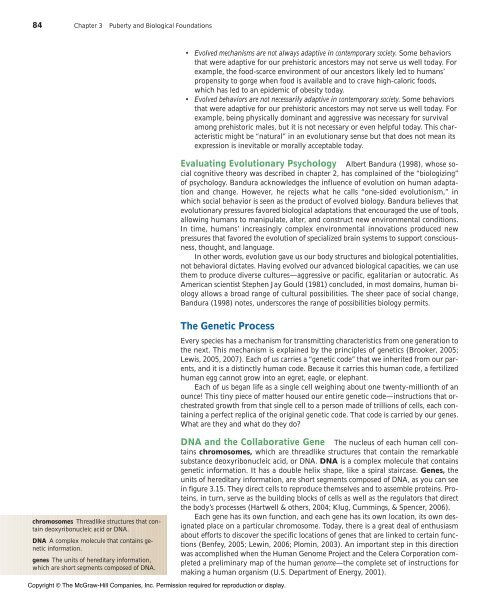Chapter 3 Puberty and Biological Foundations - The McGraw-Hill ...
Chapter 3 Puberty and Biological Foundations - The McGraw-Hill ...
Chapter 3 Puberty and Biological Foundations - The McGraw-Hill ...
Create successful ePaper yourself
Turn your PDF publications into a flip-book with our unique Google optimized e-Paper software.
84 <strong>Chapter</strong> 3 <strong>Puberty</strong> <strong>and</strong> <strong>Biological</strong> <strong>Foundations</strong><br />
chromosomes Threadlike structures that contain<br />
deoxyribonucleic acid or DNA.<br />
DNA A complex molecule that contains genetic<br />
information.<br />
genes <strong>The</strong> units of hereditary information,<br />
which are short segments composed of DNA.<br />
• Evolved mechanisms are not always adaptive in contemporary society. Some behaviors<br />
that were adaptive for our prehistoric ancestors may not serve us well today. For<br />
example, the food-scarce environment of our ancestors likely led to humans’<br />
propensity to gorge when food is available <strong>and</strong> to crave high-caloric foods,<br />
which has led to an epidemic of obesity today.<br />
• Evolved behaviors are not necessarily adaptive in contemporary society. Some behaviors<br />
that were adaptive for our prehistoric ancestors may not serve us well today. For<br />
example, being physically dominant <strong>and</strong> aggressive was necessary for survival<br />
among prehistoric males, but it is not necessary or even helpful today. This characteristic<br />
might be “natural” in an evolutionary sense but that does not mean its<br />
expression is inevitable or morally acceptable today.<br />
Evaluating Evolutionary Psychology Albert B<strong>and</strong>ura (1998), whose social<br />
cognitive theory was described in chapter 2, has complained of the “biologizing”<br />
of psychology. B<strong>and</strong>ura acknowledges the influence of evolution on human adaptation<br />
<strong>and</strong> change. However, he rejects what he calls “one-sided evolutionism,” in<br />
which social behavior is seen as the product of evolved biology. B<strong>and</strong>ura believes that<br />
evolutionary pressures favored biological adaptations that encouraged the use of tools,<br />
allowing humans to manipulate, alter, <strong>and</strong> construct new environmental conditions.<br />
In time, humans’ increasingly complex environmental innovations produced new<br />
pressures that favored the evolution of specialized brain systems to support consciousness,<br />
thought, <strong>and</strong> language.<br />
In other words, evolution gave us our body structures <strong>and</strong> biological potentialities,<br />
not behavioral dictates. Having evolved our advanced biological capacities, we can use<br />
them to produce diverse cultures—aggressive or pacific, egalitarian or autocratic. As<br />
American scientist Stephen Jay Gould (1981) concluded, in most domains, human biology<br />
allows a broad range of cultural possibilities. <strong>The</strong> sheer pace of social change,<br />
B<strong>and</strong>ura (1998) notes, underscores the range of possibilities biology permits.<br />
<strong>The</strong> Genetic Process<br />
Copyright © <strong>The</strong> <strong>McGraw</strong>-<strong>Hill</strong> Companies, Inc. Permission required for reproduction or display.<br />
Every species has a mechanism for transmitting characteristics from one generation to<br />
the next. This mechanism is explained by the principles of genetics (Brooker, 2005;<br />
Lewis, 2005, 2007). Each of us carries a “genetic code” that we inherited from our parents,<br />
<strong>and</strong> it is a distinctly human code. Because it carries this human code, a fertilized<br />
human egg cannot grow into an egret, eagle, or elephant.<br />
Each of us began life as a single cell weighing about one twenty-millionth of an<br />
ounce! This tiny piece of matter housed our entire genetic code—instructions that orchestrated<br />
growth from that single cell to a person made of trillions of cells, each containing<br />
a perfect replica of the original genetic code. That code is carried by our genes.<br />
What are they <strong>and</strong> what do they do?<br />
DNA <strong>and</strong> the Collaborative Gene <strong>The</strong> nucleus of each human cell contains<br />
chromosomes, which are threadlike structures that contain the remarkable<br />
substance deoxyribonucleic acid, or DNA. DNA is a complex molecule that contains<br />
genetic information. It has a double helix shape, like a spiral staircase. Genes, the<br />
units of hereditary information, are short segments composed of DNA, as you can see<br />
in figure 3.15. <strong>The</strong>y direct cells to reproduce themselves <strong>and</strong> to assemble proteins. Proteins,<br />
in turn, serve as the building blocks of cells as well as the regulators that direct<br />
the body’s processes (Hartwell & others, 2004; Klug, Cummings, & Spencer, 2006).<br />
Each gene has its own function, <strong>and</strong> each gene has its own location, its own designated<br />
place on a particular chromosome. Today, there is a great deal of enthusiasm<br />
about efforts to discover the specific locations of genes that are linked to certain functions<br />
(Benfey, 2005; Lewin, 2006; Plomin, 2003). An important step in this direction<br />
was accomplished when the Human Genome Project <strong>and</strong> the Celera Corporation completed<br />
a preliminary map of the human genome—the complete set of instructions for<br />
making a human organism (U.S. Department of Energy, 2001).

















